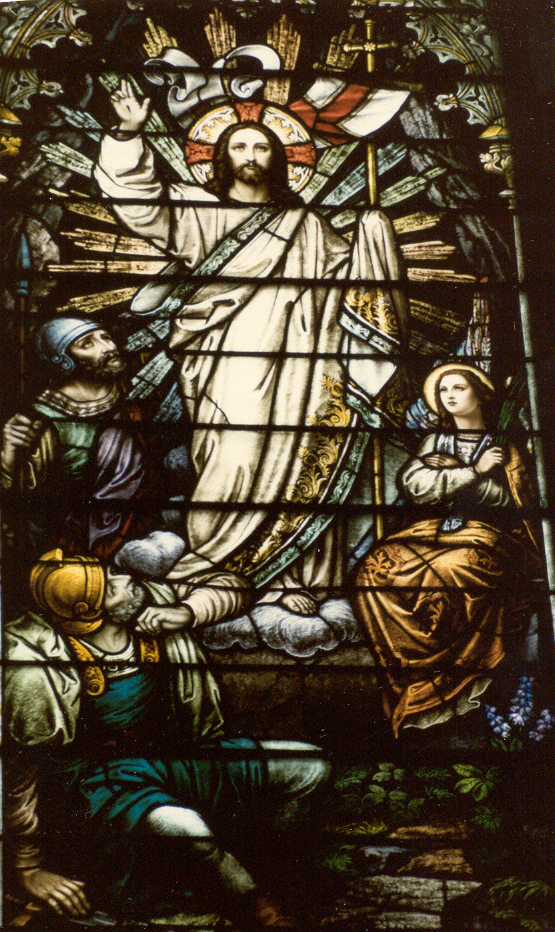
Return to
Index The Catholic Faith
Return to Level
Two Topic Index
Home Page
When Jesus died, his disciples, helped by Joseph of Arimathea, came and took his body and buried it in a tomb cut in rock in a garden. This was done in haste, because they had to prepare for the Sabbath.
But then, what? Was it all over, the glorious dream, the visible evidence of the power of God? The Messiah was dead, their beloved Jesus. The apostles were in hiding for fear of the Jewish leaders.
Then, on the first day of the week, some of the women who had traveled with Jesus and the apostles set out for the tomb with spices to anoint the body of Jesus and to tend to the details of ceremonial burial which had not been observed the day he died. On the way they began to wonder who would open the tomb for them, since a great stone had been rolled into place to seal it.

But when they got there the stone had been rolled back and an angel from Heaven was sitting on it. He informed them that Jesus, who had been crucified, had risen from the dead. He invited them into the tomb to see for themselves.
The women looked in and saw that the tomb was empty. Then the angel said: "Now he is going before you to Galilee; it is there you will see him" (Mt 28:7). The women hurried back to the apostles, filled with awe and great joy. But the apostles did not believe their marvelous news. Peter and John set out to see for themselves; they found the empty tomb, with nothing in it but the wrappings in which Jesus had been buried.
When the Apostles were gathered together Jesus suddenly appeared among them. "Peace be with you," he said. The apostles were in a panic, thinking they were seeing a ghost. Jesus reassured them, telling them that it was really him. He invited them to touch his solid flesh and asked for something to eat. They gave him a piece of cooked fish and he ate it to show that he was not a ghost.
In these and other ways Jesus helped them realize that he had risen from the dead and that he was really standing there before them. How they rejoiced! Then Jesus breathed on them, strengthening them with the Holy Spirit and giving them the power to forgive sins: "Receive the Holy Spirit. If you forgive men's sins, they are forgiven them: if you hold them bound they are held bound" (Jn 20:23). He told them that they were to be witnesses to him to all nations, beginning at Jerusalem.
After that, Jesus did not remain with them, but he appeared to them on several occasions, putting the finishing touches to his work on earth. During one of his appearances by the Sea of Galilee, he asked Peter, "Do you love me more than these others?" Peter answered yes. Twice more Jesus asked, "Peter, do you love me?" Feeling hurt, Peter answered, "Lord, you know everything. You know that I love you" (Jn 21:15-17).
Jesus was giving Peter a chance to declare his love three times before witnesses because Peter had denied Jesus three times before witnesses when Jesus was on trial. When Peter had answered his questions, Jesus instructed him, "Feed my lambs; feed my sheep." There Jesus made Peter the universal shepherd of all his followers, the first pope. At last Jesus simply said to Peter: "Follow me."
Forty days after his Resurrection, Jesus ascended to Heaven in the presence of his followers. Before this he had instructed the apostles not to go anywhere until he sent them the Holy Spirit, who would lead them in all truth and give them special power to extend Christ's Church to every part of the earth. He promised to remain with his Church always, even to the end of the world.
What happened next is recorded in the book of the Bible called the Acts of the Apostles. It tells of the coming of the Holy Spirit in the form of tongues of fire, of the conversion of St. Paul and the works of the apostles, and of the wonderful early days of the Church and the first Christian communities.
Resurrected Life
When Jesus rose from the dead on Easter Sunday he proved that he was truly the Son of God, as he had said. This meant that his death had not been in vain. He really had redeemed the world from sin. It also meant that the powers that he had given his apostles were real, and so were his promises to send the Holy Spirit and to remain always with his Church.
But Jesus did more than just pay for our sins by his death on Calvary. His Resurrection on Easter Sunday was a sign that he had also brought us new life. This new life is the life of sanctifying grace, God's own life within us, which enables us to desire and to do what God wants and what will truly make us happy.
Jesus' Resurrection is also a sign of hope that we too will one day rise from the dead just as he did.
"I am the Resurrection and the Life." (John 11:25)
Used with the permission of The Ignatius Press 800-799-5534
Return to
Index The Catholic Faith
Return to Level
Two Topic Index
Top
Home Page